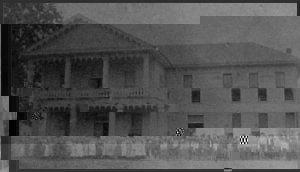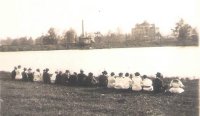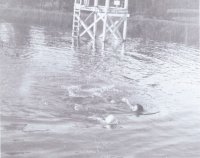|
|
Jacksonville Landmarks

Do you know this school?
School located
in Rusk.
Ragsdale Park
 |
One of the first recreational areas in Jacksonville was
Ragsdale Park.
Ragsdale Park was located on Ragsdale Creek NE of what is now the Tomato
Bowl and North of the railroad track. |
At the time of the Park's inception the Tomato Bowl did not exist.
In the background of this picture you can see what was The Old East Side
School which was located on the current site of the Tomato Bowl.
This school was completed around 1912. Thus this picture was made
1912 or later. Old Eastside was still in use in 1936 when my mother
quit teaching to marry.Ragsdale Creek also was the source of water for
The Cherokee Plunge
|
Cherokee Plunge
|
The Cherokee Plunge was the old swimming hole in Jacksonville in the latter
twenties. It was located in the Pine Hill area (Hillcrest Edition) close
to the Sam A. Cobb house on Hillcrest, and was fed by Ragsdale Creek that runs
through the edition.
|
 |
| The swimming facility/golf course were a
private venture built by the Coats family. The entrance to the
recreational facility was off Canada Street. The golf course wrapped
around the swimming hole with the first tee in the vicinity of the Bob
Greg home. An underwater platform served to create a shallow area on
which tots could play. |
 |
One of the local ministers was extremely opposed to the idea of mixed
bathing. He was responsible for having a chute (privacy fence) built so
women could exit the bath house and enter the water without being seen in
their bathing attire. When I was a child the plunge no longer existed as a
swimming hole; |
| however, the creek that fed the plunge and
surrounding mini-falls were a favorite haunt of the neighborhood kids.
The Cherokee Plunge served as the local swimming hole after Ragsdale Park,
located North of the Tomato Bowl , and before Love's Lookout. Greg
Smith, TomatoCapital.com, has Ragsdale Park images online.
If you have information to share regarding The Plunge, please contact
me via the site contact forum.
I wish I wish to thank Mary Taylor, Barbara Crossman, and Shannon Cobb
for supplying photos and information concerning The Plunge. |
Bank Clock - First National Bank
One landmark of downtown Jacksonville is the Bank Clock that stands on the
corner of Main and Commerce. Though the clock has always resided on the
corner of Main and Commerce it switched sides of the street when the Bank
moved from the south side of the street to the north side.
The clock was purchased by Mr. Parish, president of the bank, in May of
1914 for $800. Mr. Parish once lived in the house which was purchased by
members of my family in 1923. Interestingly enough he later lived in
Austin, Texas in the neighborhood in which a cousin lives.
I have seen several similar clocks over the years. One of which is
located at a building on the square in Seminole, Texas.
Thad Ray Lake or old Municipal Water Supply
Thad Ray had a lake located behind the Texas Basket Factory at the corner of Myrtle Drive and
Burma Road. Greg Smith states it is show on a 1914 map as Resevoir #2
As a child I was fascinated by the lake for it had the only water wheel I ever
had the pleasure of viewing in person.
Old marker at ths site shows the water supply was established in 1915 when M.
L. Earle was the mayor. Other councilmen included J. M. Pressler, W. L. Dublin, M. P.Alexander, T. E. Gillespie, C. R. Nunally,
O. L. Alexander. The old mill house was probably designed by S. W,
Ray, (Sidney William Ray) who did architectural work for the city and designed
the old Cith Hall/Fire Station located at NE corner of Ragsdale and Rusk
street where the bank now stands.
Other owners of the cite include: S. W. Ray, Thad Ray, a Mr. Robinson, father
of David, Robinson, and current owner J. T. Dorman .
A descendant of Thad Ray states:
I remember the lake very well. We swam out there
when I was a kid. I also remember snakes. It's a wonder how we survived
without government to protect us.
But actually I remember it as Uncle Sid's lake.
That was Thad's older brother. He was an architect and built a number of
buildings in Jacksonville. He bought it from the city, and according to my
Mom, he did that before she was a teenager. She was born in 1911. He also
built the stone building. She didn't know if he built it for the city, or
after he bought the lake. I certainly remember the building, and of course
it was in much better shape then (1940s and 1950s). I also remember the
water wheel. Since you sent no pictures of it, I assume it is long gone. I
do not remember the stone marker, nor does my Mom.
I think Thad must have bought the lake from
Uncle Sid (Sidney William) about 1960 or maybe even earlier. I know Thad
sold it before he died (1976). We don’t remember when, or to whom, or for
how much. But I guess you found that in the county records. But I remember
thinking at the time that somebody got a steal, and wishing I had known he
was going to sell it.
Amphitheater
During the days of the WPA several native stone rock work projects were
completed. These included the Tomato Bowl, The Sea Scouts boat, and the
rock work around Love's Lookout.
The highlight of the Love's Lookout work was the amphitheater built on the
side of the mountain. The theater was the site of many civic
activities including the ecumenical Easter Sunrise Service. Someone who did
not own the property sold the timber below the theater. The roots of the
timber helped stabilize the mountain side. The timber removal resulted
in the amphitheater becoming unstable and partially sliding down side of the
mountain. |
|




